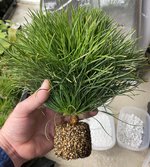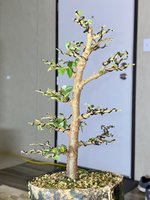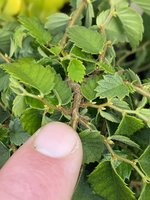One First Matter All
Mame
Hi all,
I have a question about the interaction between humic acid, pumice, and fertilizer. I have read through Bonsainut's previous posts on humic acid, and I can't seem to find the answer I seek.
As I understand it, humic acid increases the CEC (cationic exchange) of fertilizers, and this increase is especially important when using inorganic bonsai substrates. The idea is that, without either organic material in the substrate itself or else an additive like humic acid, most of the fertilizer will simply pass right through the inorganic substrate and onto the ground, with the plant receiving little in the way of its nutrients.
My question concerns the interaction between humic acid and inorganic materials like pumice. I get how humic acid binds to the fertilizer, but I don't understand how this binding solves the problem of fertilizer simply passing through the substrate--unless, that is, humic acid is especially good at binding to the substrate. Does that make sense? In other words, I want the fertilizer to "hang around" a little longer in the substrate, and it seems that, by binding to the humic acid, we have accomplished that goal, but only if the humic acid is itself "bound" to the substrate. Does humic acid "stick" to the pumice, thereby allowing the fertilizer that "sticks" to the humic acid to hang around a little longer?
I don't know enough about chemistry to answer this question, so I hope someone out there does/can.
I have a question about the interaction between humic acid, pumice, and fertilizer. I have read through Bonsainut's previous posts on humic acid, and I can't seem to find the answer I seek.
As I understand it, humic acid increases the CEC (cationic exchange) of fertilizers, and this increase is especially important when using inorganic bonsai substrates. The idea is that, without either organic material in the substrate itself or else an additive like humic acid, most of the fertilizer will simply pass right through the inorganic substrate and onto the ground, with the plant receiving little in the way of its nutrients.
My question concerns the interaction between humic acid and inorganic materials like pumice. I get how humic acid binds to the fertilizer, but I don't understand how this binding solves the problem of fertilizer simply passing through the substrate--unless, that is, humic acid is especially good at binding to the substrate. Does that make sense? In other words, I want the fertilizer to "hang around" a little longer in the substrate, and it seems that, by binding to the humic acid, we have accomplished that goal, but only if the humic acid is itself "bound" to the substrate. Does humic acid "stick" to the pumice, thereby allowing the fertilizer that "sticks" to the humic acid to hang around a little longer?
I don't know enough about chemistry to answer this question, so I hope someone out there does/can.









